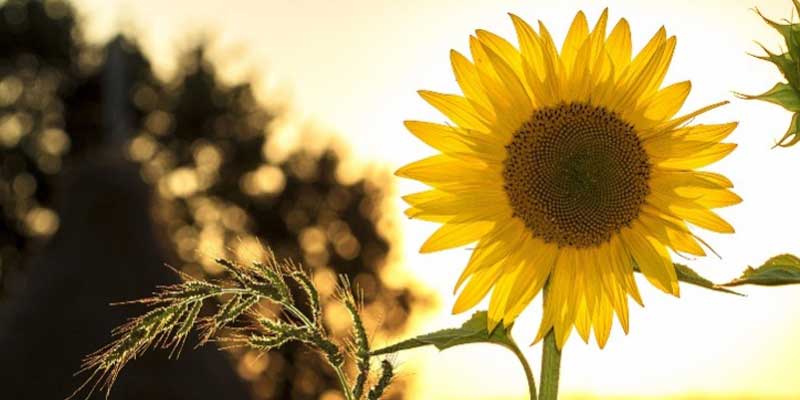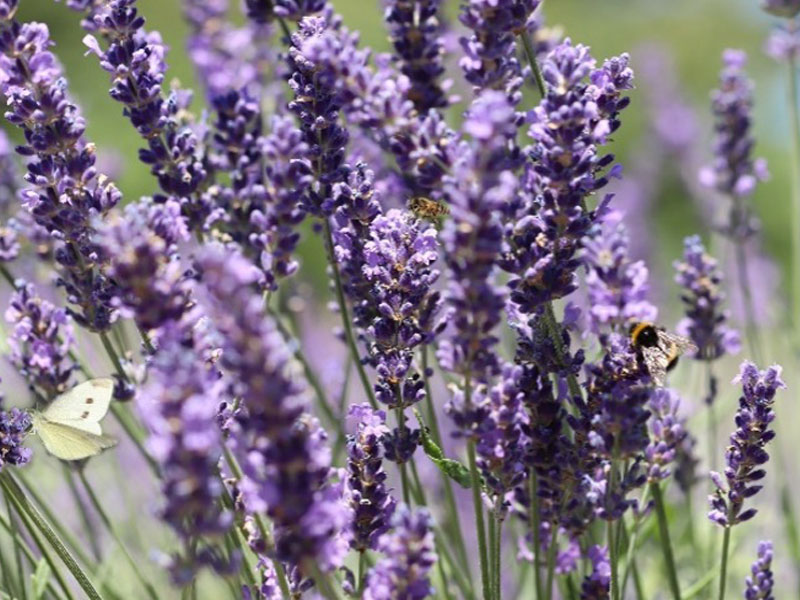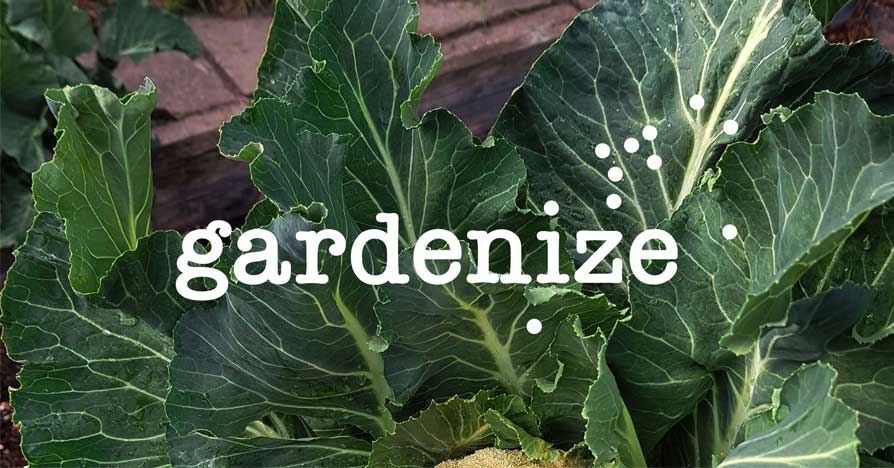REVIEWING THE GARDEN YEAR 2022
So, the last of the mince pies has been eaten and all the Christmas cards have been taken down and taken to the recycling centre. The Christmas decorations have been put away for another year, and we’ve seen the New Year in with plenty of hope for the future – not least for our gardens. If we look back, what can we learn from last year? What went well? What didn’t go quite as well as we’d hoped. And how is all this going to affect us in 2023?

Gardening and the weather!
The British have a reputation for talking a lot about the weather, and there was certainly some unusual weather to talk about in 2022.
After a fairly mild Spring, temperatures in the UK last summer soared to record heights. Coningsby in Lincolnshire, near where I live, recorded the highest temperature ever on 28th July at 40.3oC. And it wasn’t just a short period of hot weather: it went on for weeks. Not only that, but there was very little rainfall. Summer 2022 apparently ranked as the fifth driest in the UK since 1836.
All this clearly had an effect on gardens. Hosepipe bans were introduced in some parts of the country to try to minimise the amount of water used in our gardens. In some areas, these were still in effect in November. Many plants died and others suffered. Leaves wilted and scorched and fell early, and flowers failed to open. Grass turned completely brown.
Fortunately, many plants did recover, and lawns returned to their normal green. But, especially as this situation may occur in the future, lessons can be learned about the types of plants to grow and how to protect the ones that we have already.

Resolutions for 2023!
- Grow more drought-tolerant plants, such as salvias, lavenders, echinaceas, petrovskia, phlomis and sedums. Many of these plants have grey leaves, or leathery leaves which lose less water than soft leaves. The only problem with these plants (which often come from Mediterranean climates) is that they don’t like the cool, wet weather that we often experience in the UK, so the soil may need to be amended with sand or grit to improve drainage, especially if you have a heavy, clay soil.
- Another thing I’ve learned is the importance of improving soil generally so that it retains moisture. This can be done in a number of ways:
- Dig in plenty of organic material, such as manure or compost
- Keep the soil covered up, especially in winter, so that nutrients do not leach away.
- Sow green manures which can then be dug into the soil.Once the soil has been improved it can be left for the worms to carry on with the work of aerating it and breaking down organic matter.
- Store water, and water more effectively, which means, first of all, installing more water butts and other receptacles for rainwater to use in times of drought. I’ve also learnt the importance of effective watering, that is, watering plants in a way that ensures the water reaches the roots and does not evaporate from the leaves. This means aiming the watering can at the roots and watering at a time of day that is relatively cool. If a mulch is applied after planting, this helps to conserve soil moisture.
Strangely enough, after a very hot, dry summer, we had a fairly mild Autumn, and many of the plants that suffered in July were blooming well into November! After I cut back the roses, they grew again and flowered better than they had done before.
Sadly, we then had a very cold spell in mid-December, and many of the plants that had started to pick up suffered again. I didn’t get round to insulating the greenhouse with bubble wrap in time, so that, ironically, many of the cuttings I had taken (such as those of Salvia “Amistad”) as a precaution against losing plants in the garden, were killed by the cold. Note to self: insulate early next year!
Having said that, it is 1st January and the first snowdrop is already about to bloom in our garden!

THE COST OF LIVING
In the UK, as in many other countries, the rise in the cost of living has affected all of us. Energy bills have soared sky-high, and the cost of energy has an effect on everything else. The cost of sourcing food globally has also risen, and food price inflation hit 16.2% in November 2022. Are there things we can do in the garden to save money?
- Grow your own vegetables: it may sound obvious, but even growing a few of the vegetables you regularly use, or which are expensive in the shops, can save you money. Not only that, but home-grown vegetables can be grown in a much more environmentally friendly way if you decide not to use pesticides and artificial fertilisers, but, instead, make your own and make sure you practise methods like crop rotation and soil improvement in order to keep plants healthy. And they taste better!
- Look out for plants that have been reduced in price at garden centres. Most of them will recover, given a bit of care. And swap plants, cuttings, and seeds with friends – websites like Freecycle are useful for this, too.
- It’s been noticeable how expensive potting compost has become. One way round this might be to make your own. A recipe for this is:
– 1 part mature compost.
– 1 part garden loam or topsoil.
– 1 part clean builder’s sand or perlite.
- Another trick, when filling pots or raised beds, is to consider whether you need to fill them completely with compost or whether you could use material such as straw, twiggy sticks, leaves or old potting mix to fill the lower levels. This is particularly true of plants with shallower roots, such as salad crops or strawberries. But even with crops that need deep, fertile soil, such as cucumbers or squash, you can place a layer of green material, such as comfrey, at the bottom of the planting hole so that you don’t need to use as much compost. This will eventually break down and provide nutrients to the plants you are growing.
- Recycle whenever possible: re-use plant pots and trays and save cardboard to put onto the earth to act as a mulch. Make plant labels out of old plastic milk cartons.
- Make compost with spent plant material, kitchen scraps, cardboard and straw. This can be used as a mulch or at the bottom of planting holes and will retain moisture and feed your plants – or, as above, to make your own potting compost.

THOUGHTS FOR 2023
We may think that 2022 was an unusual year in the UK, but we could experience the same problems in 2023. We may get “unusual” weather, e.g. floods and droughts, and the cost of living may not come down. If we are going to make any New Year resolutions at all, maybe they should be about conserving what we have and being prepared for extreme weather conditions as far as possible. And, of course, getting out into the garden to enjoy the fruits of all our hard work!

ABOUT THE AUTHOR
Caroline Bowman has been hooked on gardening ever since she grew some thyme from seed and planted it in a window box when she lived in a flat in London. Fifty years later she is still hooked on gardening, but now she lives in Lincolnshire in England where they have quite a big suburban garden as well as an allotment, where they grow fruit and vegetables. Caroline loves flowering plants, in particular, herbaceous perennials and she likes finding out about the more unusual varieties that will do well in the English climate and soil.
GARDENIZE GARDEN APP
A gardening friend with a green thumb and photographic memory
Gardenize is an app for gardening and cultivation that helps you to overview, understand and develop your garden and your gardening skills.
Order makes it easier to succeed and Gardenize structures information and photos and makes it searchable for you. You also get tips and inspiration from other Gardenizers around the world.
Gardenize is free to use and you can download Gardenize from the App Store or Google Play, or create an account the Gardenize web app for web browsers.
Get to know Gardenize better here.



